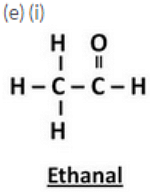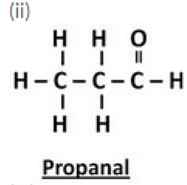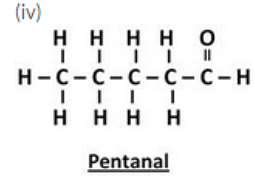Solutions of Carbon And Its Compounds (Page No - 242) - Chemistry Lakhmir Singh, Class 10 | Extra Documents, Videos & Tests for Class 10 PDF Download
Question 39:
(a) What is meant by a functional group ? Explain with an example.
(b) Write three common functional groups present in organic compounds. Give their symbols/formulae.
(c) Name the functional groups present in the following compounds :
(i) CH3COOH (ii) CH3CH2CHO (iii) C2H5OH (iv) CH3COCH2CH3
(d) Name the functional group which always occurs in the middle of a carbon chain.
(e) Draw the structures for the following compounds :
(i) Ethanal (ii) Propanal (iii) Butanal (iv) Pentanal
Solution :
(a) An ‘atom’ or ‘a group of atoms’ which makes a carbon compound (or organic compound) reactive and decides its properties (or functions) is called a functional group. The alcohol group, -OH, present in ethanol, C2H5OH, is an example of a functional group.
(b) (i) Halo group: -X
(ii) Alcohol group: -OH
(iii) Aldehyde group: -CHO
(c) (i) Carboxylic acid group
(ii) Aldehyde group
(iii) Alcohol group
(iv) Ketone group
(d) Ketone group, -CO-




Question 40:
(a) What happens when carbon burns in air ? Write the chemical equation of the reaction which takes place.
(b) Why are coal and petroleum called fossil fuels ?
(c) Explain how coal was formed in the earth.
(d) Describe how petroleum was formed in the earth.
(e) Name a fossil fuel other than coal and petroleum.
Solution :
(a) When carbon is burned in air, it forms carbon dioxide gas and releases a large amount of heat and some light:
C +02 → C02 + Heat + Light
(b) Coal and petroleum are called as fossil fuels because they were formed by the decomposition of the remains of the pre-historic plants and animals (fossils) buried under the earth long, long, ago.
(c) Coal was formed by the decomposition of large land plants and trees buried under the earth millions of years ago. It is believed that millions of years ago, due to earthquakes and volcanoes, etc., the forests were buried under the surface of the earth and got covered with sand, clay and water. Due to high temperature and high pressure inside the earth, and in the absence of air, wood was converted into coal.
(d) Petroleum oil (and natural gas) was formed by the decomposition of the remains of extremely small plants and animals buried under the sea millions of years ago. It is believed that millions of years ago, the microscopic plants and animals which lived in seas, died. Their bodies sank to the bottom of the sea and were soon covered with mud and sand. The chemical effects of pressure, heat and bacteria, converted the remains of microscopic plants and animals into petroleum oil and natural gas just as they converted forest trees into coal. This conversion took place in the absence of oxygen or air. The petroleum thus formed got trapped between two layers of impervious rocks (non-porous rocks) forming an oil trap.
(e) Natural gas.
|
5 videos|292 docs|59 tests
|
FAQs on Solutions of Carbon And Its Compounds (Page No - 242) - Chemistry Lakhmir Singh, Class 10 - Extra Documents, Videos & Tests for Class 10
| 1. What are the different forms of carbon? |  |
| 2. How does carbon form compounds? |  |
| 3. What is the importance of carbon compounds in our daily life? |  |
| 4. How do carbon compounds contribute to environmental pollution? |  |
| 5. What are some examples of carbon compounds? |  |
|
5 videos|292 docs|59 tests
|

|
Explore Courses for Class 10 exam
|

|

















